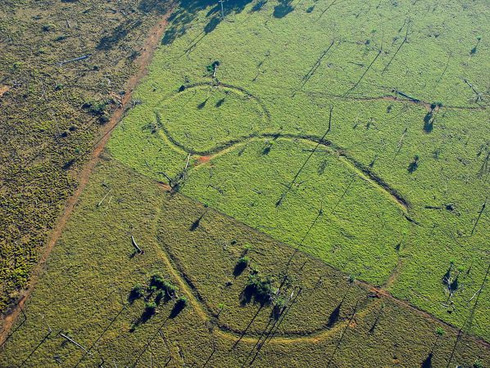Ancient Amazon Earthworks Seen by Satellite
Amazonia is not the “wilderness” many assume it to be. For thousands of years human beings have been residing in and cultivating (for agriculture) lowland and upland areas across the Amazon basin and beyond.
A recent article in National Geographic News provides a glimpse of earthworks built long before Columbus. Rediscoveries of the ancient croplands and city sites force us to re-evaluate notions of wilderness and to consider the long-standing, organized, cultural interactions and influences of humanity upon western landscapes.
The Nat Geo News article (below) cites Denise Schaan and William Woods, historical landscape geographers whose research we have posted (in small part) at the W.I.S.E. Colloquium: History of Western Landscapes. Among our Amazonia references are:
* William Woods et al. (including Dr. Schaan). 2009. Amazonian Dark Earths: Wim Sombroek’s Vision [here]
* Michael J. Heckenberger et al. 2007. The legacy of cultural landscapes in the Brazilian Amazon: implications for biodiversity [here]
* William M. Denevan. 2001. Cultivated Landscapes of Native Amazonia and the Andes [here]
* Charles C. Mann. 2008. Ancient Earthmovers Of the Amazon [here]
* William Denevan. 1992. The Pristine Myth: The Landscape of the Americas in 1492 [here]
* Charles C. Mann. 2005. 1491: New Revelations of the Americas Before Columbus [here]

Ancient Amazon earthworks seen by satellite
“Lost” Amazon Complex Found; Shapes Seen by Satellite
by John Roach, for National Geographic News, January 4, 2010
Hundreds of circles, squares, and other geometric shapes once hidden by forest hint at a previously unknown ancient society that flourished in the Amazon, a new study says.
Satellite images of the upper Amazon Basin taken since 1999 have revealed more than 200 geometric earthworks spanning a distance greater than 155 miles (250 kilometers).
Now researchers estimate that nearly ten times as many such structures—of unknown purpose—may exist undetected under the Amazon’s forest cover.
At least one of the sites has been dated to around A.D. 1283, although others may date as far back as A.D. 200 to 300, said study co-author Denise Schaan, an anthropologist at the Federal University of Pará in Belém, Brazil.
The discovery adds to evidence that the hinterlands of the Amazon once teemed with complex societies, which were largely wiped out by diseases brought to South America by European colonists in the 15th and 16th centuries, Schaan said.
Since these vanished societies had gone unrecorded, previous research had suggested that soils in the upper Amazon were too poor to support the extensive agriculture needed for such large, permanent settlements.
“We found that this picture is wrong,” Schaan said. “And there is a lot more to discover in these places.”
Wide-reaching Culture
The newfound shapes are created by a series of trenches about 36 feet (11 meters) wide and several feet deep, with adjacent banks up to 3 feet (1 meter) tall. Straight roads connect many of the earthworks.
Preliminary excavations at one of the sites in 2008 revealed that some of the earthworks were surrounded by low mounds containing domestic ceramics, charcoal, grinding-stone fragments, and other evidence of habitation.
But who built the structures and what functions they served remains a mystery. Ideas range from defensive buildings to ceremonial centers and homes, the study authors say.
It’s also possible the structures served different purposes over time, noted William Woods, a geographer and anthropologist at the University of Kansas in Lawrence who was not involved in the research.
“For example,” he said, “in Lawrence there’s a Masonic temple—it is now a bar. There was a bank—it is now a restaurant called Tellers. These things happen.”
What most surprised the research team is that the earthworks appear in both the region’s floodplains and the uplands.
In general, the Amazon’s fertile floodplains have been popular sites for ancient civilizations, while the sparser uplands have been thought to be largely devoid of people, the researchers say.
What’s more, the earthworks in both regions are of a similar style, suggesting they were built by the same society.
“In Amazonian archaeology you always have this idea that you find different peoples in different ecosystems,” study co-author Schaan said.
“And so it was kind of odd to have a culture that would take advantage of different ecosystems and expand over such a large region.”
“Astounding” Population
The uplands sites appear to have been home to as many as 60,000 people, Schaan and her colleagues suggest in their paper, published this month in the journal Antiquity.
That figure is based on estimates of the social organization and labor that would have been required to build the structures hinted at by the remaining earthworks.
According to the University of Kansas’ Woods, the population estimate is reasonable, albeit rough, since so little is known about these complexes.
Answers may emerge as researchers continue to excavate the newfound shapes in the coming years.
But Woods is impressed by the possibility that so many people might have once lived in a region long thought uninhabited.
“Traditionally, if you would have asked an anthropologist or archaeologist how many people lived [in these Amazon uplands], they’d say almost zero,” he said.
“And so this is astounding that there is 60,000 people making a go of it where there aren’t supposed to be any.”
by YPmule
Yup. They miss the point, however. Organic gardening with charcoally compost is a peripheral (and only marginally interesting) issue.
The KEY findings are that our landscapes have been home to humanity for millennia, and that all during that residency we have been stewards of the land.
Wilderness is a myth. Stewardship is preferable to abandonment. We are the caretakers. There is no man apart from nature. Etc.

Even Mother Earth News has picked up on this and wrote an article about “biochar” that folks can make and incorporate into their gardens.
http://www.motherearthnews.com/Organic-Gardening/Make-Biochar-To-Improve-Your-Soil.aspx
See also:
New Biochar Stoves at the 2009 ETHOS Conference
http://www.motherearthnews.com/Hands-On-How-To/Biochar-Stoves.aspx